Guy Diehl's second solo show at Dolby Chadwick Gallery, "A Dialogue with Tradition," consists of a suite of still life paintings that feature bottles, blocks, spheres and boxes. The painting's objects make references to modern art and artists -- including Piet Mondrian, Giorgio Morandi, and Robert Delaunay -- but Diehl's technique alludes to 17th century Baroque painting. A major theme of the exhibition is "art about art," but the show is also a visual feast that offers viewers a chance to contemplate transparency, the sparkle of light on glass, and the mesmerizing illusion of three dimensionality that a only a highly skilled painter can achieve.
I recently interviewed Guy Diehl and asked him about his background, his ideas and his works as painter, muralist and tapestry artist.
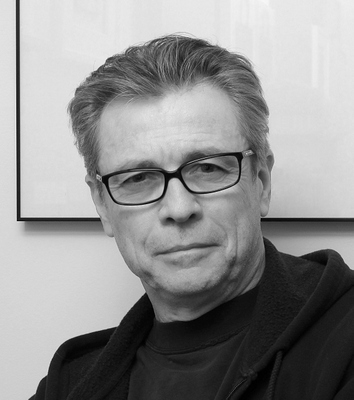
Guy Diehl
John Seed Interviews Guy Diehl
Tell me a bit about your background and your art education.
I was born in Pittsburgh, Pennsylvania in 1949. As a kid with dyslexia, my early induction into the world of self-expression was met with criticism rather than acclaim. In Catholic grade school I was sent to the Mother Superior for doodling at my desk when I should have been doing the assignment. On my way to her office, I was marched through the church where large religious oil paintings were displayed. I was so affected by their realism that at that young age, I decided that I needed to know more about art.
Throughout grade school, my parents would say, Yeah, you can draw things, but how are you going to make a living? You can't read. When I would draw something realistically, I would hear: Wow! How did you do that? That looks so real.
At the age of eight I stumbled upon the magic of linear perspective and with this new perception suddenly a whole new world was unlocked. From that point on, there wasn't anything else I was interested in. All this played a part in how I would deal with my dyslexia and shape my life and career as an artist. Through grade school and high school my attention never wavered. I knew that my future would somehow be in the art world.
In 1960 my family moved to Northern California and settled east of San Francisco, in the town of Concord. As a senior at Clayton Valley High School in 1967, I had completed all the art classes offered at the school. While looking forward to further study at the college level, I took a job creating silk screen posters for a dance venue on campus. It was the dawn of a new age and psychedelic posters were the rage.
One poster I completed, which featured Louis Carroll's hookah smoking caterpillar from Alice in Wonderland was met with criticism. As it hung on campus, it was viewed as a symbol of the current social movement in this country. As some parents demanded that it be removed, a discourse on freedom of expression ensued which made the front page of the local paper. That incident was my first strong realization that art had power, and that art could be a catalyst for emotional debate.
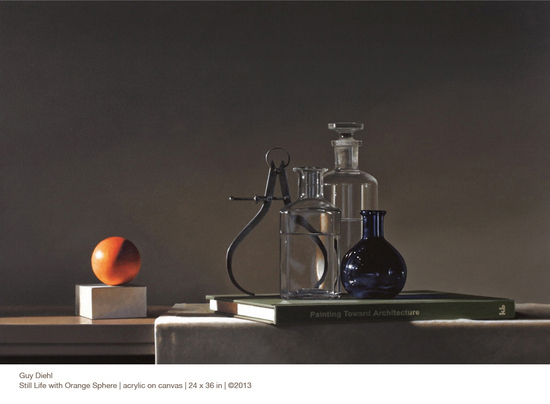
During the years 1968-1970 I attended Diablo Valley Community College in Pleasant Hill, CA. After completing prerequisite courses, I headed to California State University at Hayward, California. At Hayward, I studied with Pop artist Mel Ramos and multimedia artist Raymond Saunders, graduating with my BA in Art in 1973. During this period of time, Photo Realism was well established and part of the mainstream painting in the Bay Area. I was greatly influenced by the classes I took from Mel Ramos at Hayward. He encouraged me to do my graduate work at San Francisco State University and to study with the photorealist artists Richard McLean and Robert Bechtle.
In 1974 I was accepted into the graduate program at SFSU and graduated with honors in 1976. From this point on, a ten-year exploration of Photo Realism in acrylic paintings and watercolors ensued. My paintings at that time all centered on the unique California lifestyle which included the swimming pool and beach scene. I would set up the compositions using towels, drinks, chairs and lounges. At first, my paintings centered on the figure at ease around the pool. After a period of time, I started painting everything but the human figure. It was as if the people had stepped away, and the viewer was left with the paraphernalia of the sunbather. I did not realize it at the time, but this was to be a period of transition which would lead me to the genre I am now most connected to: the Still Life.
In 1976, fresh out of graduate school, I became a faculty member at Diablo Valley College in Pleasant Hill, CA. I taught painting, drawing and watercolor. Over the next 20 years, as I continued to paint, I was a faculty member at several colleges in the San Francisco Bay Area.

Your paintings are very refined and completely realized: have they always been that way?
This refined look of my work has always been there, even as a kid I drew things to look real. My dyslexia and the anxiety of what I was going to do with my life, pointed me in the direction of realism. At the same time, (the mid 60s) photorealism was taking hold as an art movement along with Pop Art. Any positive recognition that I received growing up was because I could render or copy things that showed realism.
In 1968 I enrolled in my first college art class: Painting 101. With each assignment I focused on realism as a solution. Forty-five years later, I'm still at it.
As a representational artist, I see myself as an interpreter, who is making a record of his observations. These observations are intuitive, as well as responsive to images within the composition. The satisfaction with my work comes when I can make a painting as minimal as possible and still capture the fundamental appearance of the subject matter. To know what to paint and what to exclude is the challenge. This distillation helps reveal the essence of a painting. As I continue this exploration, I'm challenged to take my work further both in content and subject matter. I see the refinement and depth that I want from my work grow and evolve as I move closer to what is most important to me; to make a worthy painting that connects me with the world both past and present.
During this period of still life. I started to focus on the book as the primary subject matter in my paintings. I use the book as a vehicle to add the commentary aspect to the subject matter and act as unifier to the whole. Within this series of Book paintings, compositional references are made to Cubism; German Expressionism; the music of Jazz; Abstract Expressionism; and to the artists of the early Modernism period from 1900 to the 1950s. These paintings express the underlying content and importance that the "book" gives to my still life work. My hope is to first capture the viewer's attention with the objects themselves, then by the choice of books and their titles I encourage the viewer's further reflection on the work, which provides the subtext to the initial first visual impression. By selecting and arranging objects, I can then introduce a narrative into my paintings.

Can you say a few things about your working methods?
I have always worked in a series. In the 70s it was a photorealism "Swimming Pool" series with the figure. In 1985 I started my "Still Life" series. From that first painting class in 1968, all of my work on canvas has been done in acrylic. I also work with watercolor on paper.
I work from a source image that I've photographed. For the still life series, subject matter is composed and photographed, later reviewed in all it's variations to determine whether or not it is suitable for a good painting.
The process of making a painting boils down to my 45 years of working with acrylics. Today the challenge is not whether I can paint something realistic. It's what to paint... and how to compose a group of objects in controlled light and shadow that will reveal some sense of order without being overly contrived or familiar.
I paint only what I think is appropriate and leave out what's not necessary. By paying attention to only the important details that the direct and reflective light reveal, I can make a painting that's more interesting. I think this is a universal problem that representational artists have dealt with all along; putting in too much detail versus not enough.
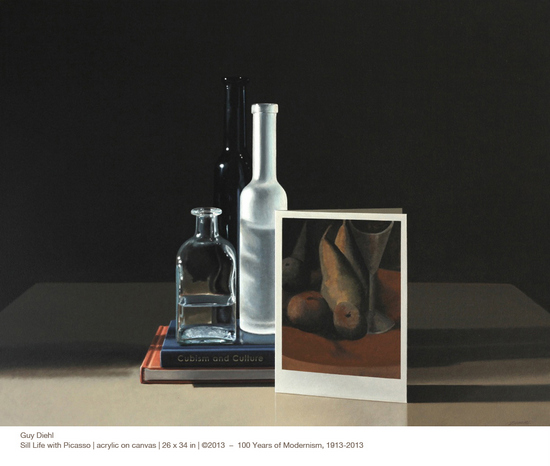
Your recent works have a very pronounced atmosphere, and a new range of forms. How has all of this come about and why?
Here is some of the backstory to the Still Life series.
In 1984 my subject matter began to change from the swimming pool paintings when I started to look at the Bay Area painter Gordon Cook and his exquisite, minimal still life. His work changed my idea of what still life painting was and showed me what it could be. I began painting smaller, more intimate works where I could work faster and execute an idea in a shorter period. This newfound freedom moved me to a higher level and allowed me to produce more and to move away from the strict Photo Realism style of painting, to a more flexible interpretation of what I was seeing. In these small still life paintings I incorporate visual references that would soon incorporate the idea of art about art.
The idea of pronounced atmosphere in my work came about soon after I started the Still Life series in 1985. Light and shadow, whether sun light or incandescent, light has always been an important factor in my work as a realist. It's the light that falls on an object that is most important to me, almost more important than the subject matter. The angle at which a light is focused on an arrangement of objects has always evoked a great sense of power, depth, and emotion. The task of lighting a scene is an art in itself, such as the dramatic lighting you would see in a Film Noir movie.
More recent paintings have incorporated new objects. Out of a need to move to the next level, I'm always on the look out for what might be good to paint. I try to stay away from nostalgic subject matter, like old kitchen and home appliances. There are plenty of still life painters doing that already. Like Giorgio Morandi, I look for things that have symmetry and grace in their shape. The simple form: the cube, cone, cylinder, sphere, rectangle, all placed in that light of pronounced atmosphere. It's all about the light and shadow.

Who are some of the artists you admire most, living and dead?
Boy, there are many...
Giorgio Morandi, Wayne Thiebaud, Gordon Cook, David Ligare, Jeffery Ripple, Elmer Bischoff, Ralph Goings, John Singer Sargent, Chardin, Vermeer, Modigliani, Picasso, Franz Kline, de Kooning, Rothko, Edward Hopper, Marcel Duchamp, Man Ray: I could go on and on.
More recently, self-taught, folk art artist, Bill Traylor...
Some of the influential professors I have studied with are Mel Ramos, Ray Sounders, Richard McLean and Robert Bechtle.

Guy Diehl with his mural "Still Life with Billie Holiday," Davis, California. Photo: John Seed
A few years ago you completed a public mural in Davis. What was it like to bring your imagery to that level of scale, and what have the reactions been?
I volunteered to do the mural in Davis without knowing what I was getting into. It was Kelly Detweiler who said....Oh, come on Guy; join us. It'll be fun. Well, it was a lot of fun. As a team of ten, we prepared and worked on each mural to a point where the artist could then take over their mural to completion. I was the seventh mural in the series of 12, and was more confident in doing it by then. There was a lot of concern in my mind as to whether or not I could pull this off.
Scaling my work from a canvas painting to 9 by 11 feet was the challenge. Getting the image on the wall was no problem. We would project and trace off the outline needed to get started. The actual painting was a group effort. The team helped get areas rendered to a point where I could take over and introduce my style to create the finished look. Five days later I was able to say it's done and feel good about the mural. I would have to say, it was one of the most rewarding projects of my career. The positive reaction to all the murals has been more than we imagined, every one seems to love the art. It definitely has made Davis a place to stop, look at art and take in the town.
The reaction to my mural, Still Life with Billie Holiday has been quite favorable. To be able to direct the viewer's thoughts to her... and the music she created, is my tribute to her. If you would like to view the mural, you can locate it on the Davis Art Walk website.
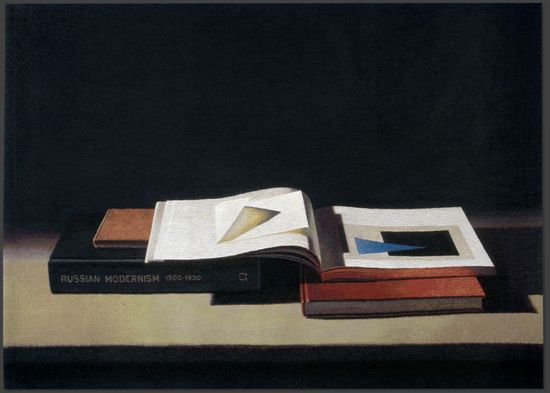
Still Life with Kasimir Malevich, 2007, Jacquard Tapestry, 54 x 76 inches, edition of 8
Image: Magnolia Editions
Please say a few things about your recent work with Magnolia Editions.
Since 1988, I've had an ongoing working relationship with Don & Era Farnsworth at Magnolia Editions Fine Art Press. We have been producing state of the art limited edition lithographs, etchings, woodcut and woven Jacquard tapestries from my still life series. Currently, we are working on Hybrid prints. Combining traditional hand pulled woodblock and etching prints with digital applications of color. I find it very exciting to be at the forefront of this technology at Magnolia. It has unlocked new avenues to exhibit my work and make it accessible to a wider audience.
One of the more exciting mediums of exploration at Magnolia is the tapestry project. Working with Don, we have transformed four of my paintings into large format Jacquard tapestries, averaging 6 x 7 feet. The goal is not to reproduce a painting verbatim into a woven image, but to incorporate that image into a centuries old textile process which has been enhanced by new technology.
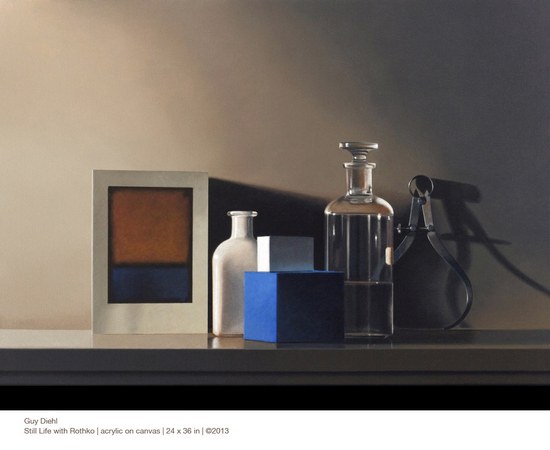
What are your interests outside of art?
Cooking for family and friends, mountain biking, collecting vintage 20th century cameras and chess are a few: and being totally in love with my high school sweetheart.
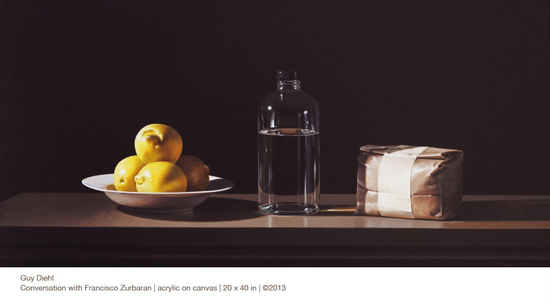
When visitors see your work in person at Dolby Chadwick, what do you hope they will notice and appreciate?
I hope to encourage the viewers to see a sense of uniform balance and harmony in the work as a whole, as well as in each of the paintings in the exhibition. I also hope viewers will recognize and understand my references to art history and artists that are remixed within the compositions and that my work conveys as much about the manipulation of paint on canvas as it does about realism.
As they observe the works, I hope that viewers will take a moment and pause with the idea that "less is more," and will notice the virtue of an object illuminated within a spatial arrangement. Finally I hope they will walk away with a need to see more art that is well executed and removed from the mediocrity that often seems to accompany the Still Life genre.
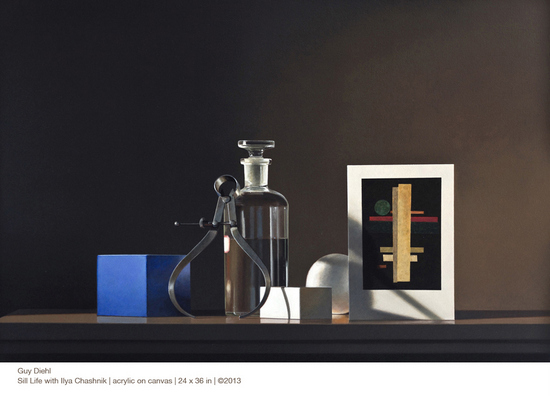
Guy Diehl
A Dialogue with Tradition
September 5 -- 28, 2013
Opening Reception: Thursday, September 5, 5:30-7:30 PM
Dolby Chadwick Gallery
210 Post Street, Suite 205
San Francisco CA, 94108
